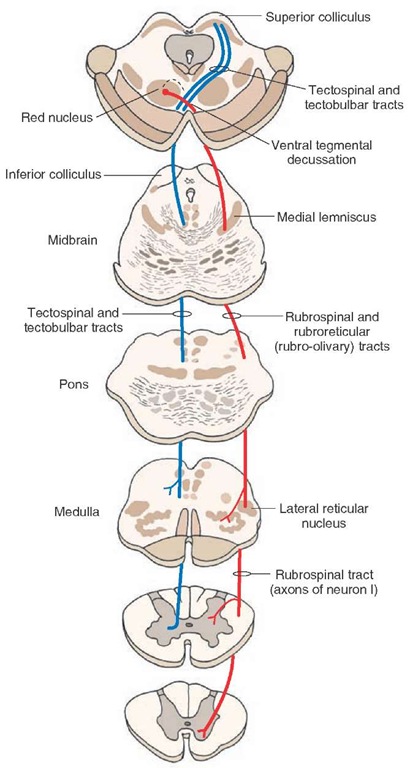Rubrospinal Tract
Original Editor - Your name will be added here if you created the original content for this page.
Lead Editors - Kate Sampson, Lucinda hampton, Evan Thomas, Wendy Walker, WikiSysop and Kim Jackson
Description[edit | edit source]
The Rubrospinal tract is a descending pathway which originates in the Red Nucleus and descends to the spinal cord.[1]
Anatomy[edit | edit source]
Origin[edit | edit source]
- The Red Nucleus of the midbrain tegmentum [1]
Course / Path[edit | edit source]
- Fibres pass ventromedially and cross the ventral tegmental decussation.
- Fibres descend to the spinal cord where they lie ventrolateral to and intertwined with the corticospinal tract.
Function[edit | edit source]
- As the Rubrospinal tract recieves afferent fibres from the motor cortex and cerebellum it acts as a non pyramidal route of influencing spinal cord activity through inter and motor neurones [1][2]
- Excitation of the motor neurones controlling tone of limb flexor muscles and inhibitory to extension during of gait[1][3]
- Facilitatory of flexion and inhibitory to extension in cervical and lumbar spine and distal extremity muscles [4]
- Neural activity in the red nucleus is related to force, velocity and direction of movement. [5]
Pathology[edit | edit source]
Within literature selective lesions have not been reported of solely red nucleus or rubrospinal tract. Lesions of the region of the red nucleus can result in movement disorders and tremor, but these effects may be more associated with damage to fibers of associated with cerebellar and basal ganglia systems [6]
Recent Related Research (from Pubmed)[edit | edit source]
References[edit | edit source]
- ↑ 1.0 1.1 1.2 1.3 Crossman AR, Neary D. Neuroanatomy: An Illustrated Colour Text. Third Edition. London: Elsevier, 2004
- ↑ Martinez-Lopez1 JE, Moreno-Bravo1 JA, Madrigal1 MP, Martinez1 S, Puelles1 E. Red nucleus and rubrospinal tract disorganization in the absence of Pou4f1. Front. Neuroanat 2015;9:8.
- ↑ Kidd G, Lawes N, Musa I. Understanding Neuromuscular Plasticity. London: Edward Arnold, 1992.
- ↑ Rothwell J. Control of Human Voluntary Movement. London: Chapman & Hall, 1994
- ↑ Leonard CT. The Neuroscience of Human movement. St Louis:Mosby 1998
- ↑ What-When-How. The Upper Motor Neurons (Motor Systems) Part 3. http://what-when-how.com/neuroscience/the-upper-motor-neurons-motor-systems-part-3/ (accessed on 1/4/2016)







